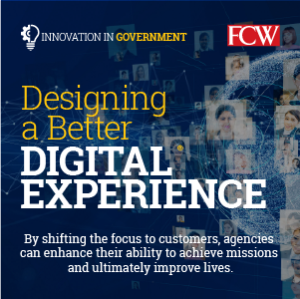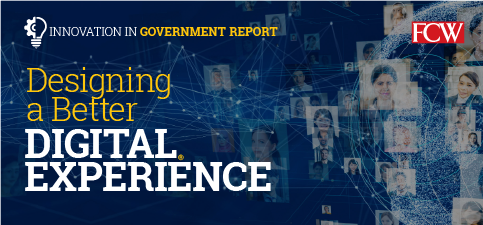The government’s ability to offer meaningful digital engagements has long trailed behind that of the private sector. In the American Customer Satisfaction Index’s “Federal Government Report 2019,” citizen satisfaction with federal services fell for the second consecutive year — to 68.1 on a 100-point scale. Despite this, lawmakers and agency leaders of all levels are making efforts to improve the digital experience for government customers. In a recent FCW survey, 61% of participants said their agencies have already begun modernizing websites, 58% are digitizing forms, 51% are implementing e-signatures and 26% have begun providing personalized content. Learn the latest insights from industry thought leaders in Digital Experience in Carahsoft’s Innovation in Government® report.
 Developing a Digital-First Mindset
Developing a Digital-First Mindset
“Today government forms are mostly paper-based or perhaps available as static, non-fillable PDFs that must be printed, filled out and mailed, faxed or submitted in person. Instead, the goal should be mobile-friendly web-based forms that are filled through a series of interview-style questions, similar to the way TurboTax and other programs work. The web form guides the user through the appropriate data collection and prepopulates the information the agency already knows about that person so customers don’t have to submit the same information multiple times. The customer can submit the final application or form securely via a trusted authentication solution such as Login.gov, which interfaces with Adobe’s Experience Management platform so anyone who has a secure credential through government programs such as Trusted Traveler can use that credential for transactions with other agencies.”
Read more insights from Adobe’s Technical Director of Digital Government Solutions, Jonathan Benett.
Maintaining Productivity in Times of Crisis
“A well-managed organization understands its data, workflows, resources and networks. It knows how services are provided, who and where the employees are, and who the contractors are. And it understands the importance of proper IT operations management. When disaster strikes, those organizations are better prepared to make the adjustments that are necessary to continue providing customer service and support their employees’ needs so they can operate as though nothing has changed. It’s important to digitize office workflows ahead of time so that those processes can seamlessly transition to telework environments when a crisis hits. During such disruptions, IT leaders need to know how many software licenses they have for videoconferencing, VPNs and other remote tools.”
Read more insights from ServiceNow’s Principal Digital Strategist for the Federal Government, Jonathan Alboum.
Adapting CX on the Fly with AI and Cloud
“Artificial intelligence and automation represent some of the greatest promise we’ve seen to transform the customer experience. Roughly 30% of calls to an agency are some variation on a status check. During the coronavirus crisis, many people have been contacting the government to find out where they can get a test for COVID-19, the status of test results or what to do if they have certain symptoms. Responses to those requests are repeatable tasks, and the government’s ability to respond is constrained because employees need to set up testing stations, process tests or attend to people who are ill with COVID-19.”
Read more insights from Genesys’s Senior Vice President of U.S. Public Sector, David York.
How Context Enriches CX
“During the Coronavirus pandemic, the traditional boundaries for security have been dissolved. When government employees could not go into their offices, they needed to be able to do their jobs remotely. But an employee signing in from an iPad at home must be treated differently from the same user signing in on an office computer. That meant agencies had to move security from the boundary of the network to the identity of each individual. Fortunately, advances in authentication are giving us a deeper understanding of the context around employees’ activities, which makes the process more secure without hindering the end user’s productivity. In other words, agencies can achieve a higher level of assurance about each individual user’s risk. For instance, we can do risk scoring for users and tap larger datasets to identify known bad IP addresses. By looking at a user’s geolocation, we can flag a sign-in attempt coming from, say, Nigeria or North Korea for a government employee who is clearly not in either location.”
Read more insights from Okta’s Solutions Engineer, Habib Hourani.
The Path to Secure, Seamless CX
“Creating a responsive experience for citizens also benefits from predictive machine learning combined with omnichannel communications. A successful implementation starts with a deep understanding of customers, why they are engaging and what outcome they expect. Artificial intelligence, coupled with the latest authentication practices, can boost customer engagement by allowing agencies to sharpen their focus on the user, whether it’s a citizen, employee or partner organization. The approach has the added benefit of reducing costs for agencies at all levels of government because it shortens the amount of time agents must spend on resolving calls and results in fewer callbacks. Doing the right thing on the first interaction improves outcomes dramatically and delivers a better customer experience while enhancing employee engagement.”
Read more insights from Nuance’s Director of Government Sales, Russell Brodsky.
The Digital Government of the Future
“Government agencies have access to more sensors and more data sources than ever before, but they need appropriate automation technology to make timely decisions. Artificial intelligence and the subfield of machine learning provide mechanisms for decision-makers to get more value out of their information by enabling faster analysis of more data. Most federal agencies have too much data to analyze manually. Take the U.S. Geological Survey, for example. USGS works with NASA to distribute data from Landsat satellites and provide remote sensing photographs of the Earth. Millions of photos have been collected since 1972 — far too many for any organization to manually analyze every photo for information about how the world is changing.”
Read more insights from Salesforce’s Director of Digital Strategy of Global Public Sector, Tahera Zamanzada.
Download the full Innovation in Government® report for more insights from these government Digital Experience thought leaders, additional industry research from FCW and an interview with Charles Worthington, CTO of the Department of Veterans Affairs.







